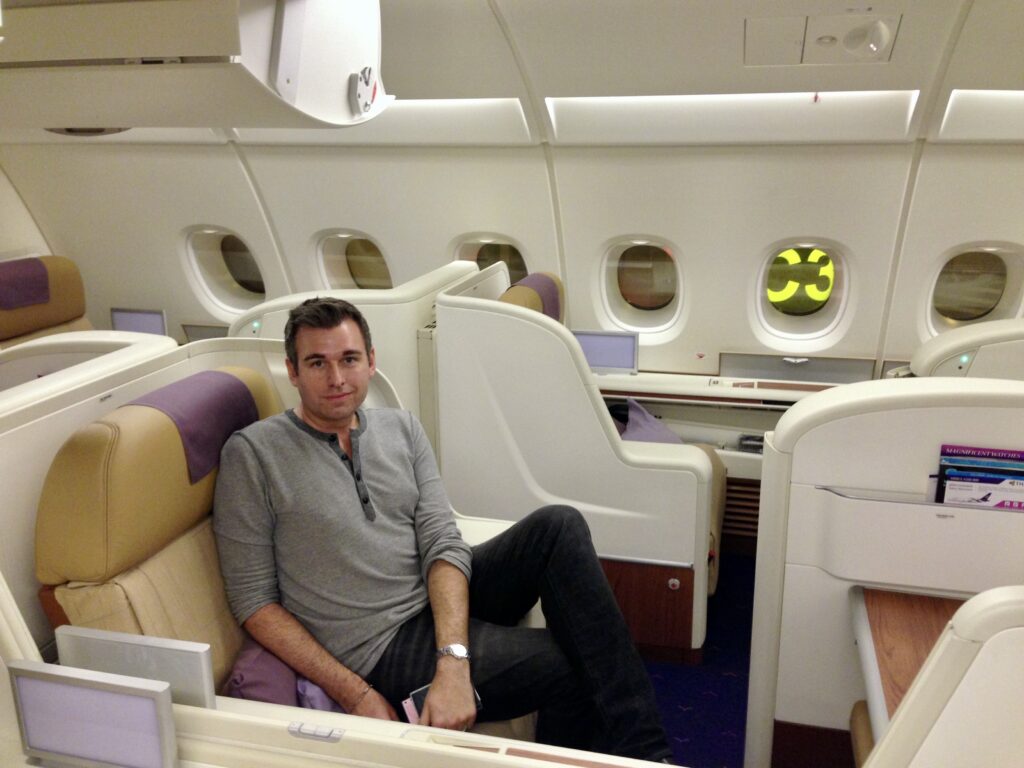Advertiser & Editorial Disclosure: The Bulkhead Seat earns an affiliate commission for anyone approved through the links below. This compensation may impact how and where links appear on this site. We work to provide the best publicly available offers to our readers. We frequently update them, but this site does not include all available offers. Opinions, reviews, analyses & recommendations are the author’s alone, and have not been reviewed, endorsed, or approved by any of these entities.
Thai Airways announced that it plans to eliminate First Class service within the next two to three years. The move comes as part of a new strategy to modernize the airline’s fleet, enhance the passenger experience across all cabins, and regain market share at Bangkok’s Suvarnabhumi Airport (BKK).
Chai Eamsiri, CEO of Thai Airways, confirmed in an interview with Thai news outlet, Prachachat, that the carrier’s new focus will be on strengthening its competitive edge through aircraft upgrades and elevated Business Class service. It will introduce a standardized three-class configuration: Business Class, Premium Economy, and Economy.
The decision to scrap First Class follows a global aviation trend where many international carriers are scaling back or eliminating their most exclusive cabins in response to declining demand and the improvements made to Business Class offerings.

Currently, Thai Airways offers First Class only on three Boeing 777-300ERs that are used to serve flights to/from London Heathrow Airport (LHR) and Tokyo Narita Airport (NRT). The airline’s First Class footprint has already been significantly reduced with the retirement of the Airbus A380 (I loved flying First Class with Thai on this aircraft) and the Boeing 747-400 fleets during the pandemic.
To bridge the gap between standard Business Class and the traditional First Class experience, upgraded premium seats will be introduced in the front rows of each Business cabin. This will give travelers additional space and amenities without the First Class pricing.
Thai Airways’ transformation strategy centers around fleet renewal and modernization. This includes:
- Airbus A320 Upgrades: 20 A320 narrow-body aircraft will be converted from an Economy-only layout to a two-class configuration (adding 12 Royal Silk Class (Business Class) seats.
- New wireless in-flight entertainment systems are being installed (with the entire refit to be completed by the end of 2025).
- Two Airbus A321neo aircraft will arrive later this year and15 more scheduled for delivery in 2026.
- 14 Boeing 777-300ERs will be refurbished over the next two years. These will feature Business Class suites with privacy doors as well as redesigned Premium Economy and Economy Class cabins.
- 20 Airbus A350s will receive cabin upgrades beginning in 2028.
- Thai Airways will also take delivery of 45 Boeing 787 aircraft (with the first nine arriving in 2028).
None of these aircraft will feature First Class cabins to align with the new three-class standardization strategy. The airline’s fleet will grow from 78 aircraft today to 150 by 2033. This will include 15 Boeing 777-300ERs, 17 Airbus A350s, 66 Boeing 787s, and 52 Airbus A320 and A321neo aircraft.
Thai Airways aims to capture 35% market share at Bangkok’s Suvarnabhumi Airport (BKK) by 2029 with a long-term goal of returning to 42%. Chief Commercial Officer Kittipong Sarasombat highlighted that standardizing cabins will streamline operations and reduce costs while allowing the airline to offer competitive pricing and consistent service quality. This strategy also aligns with Thai Airways’ broader recovery plan following its exit from financial reorganization and return to the Thai Stock Exchange. By focusing on high-value cabins and modern aircraft, the airline expects to boost profitability and customer loyalty.
Anthony’s Take: I’ve enjoyed flying First Class on Thai Airways in the past and hope to fly the carrier again in the future. It’s modernization strategy makes sense as most airlines have shied away from having an International First Class cabin.
(Featured Image Credit: Thai Airways.)
User Generated Content Disclosure: The Bulkhead Seat encourages constructive discussions, comments, and questions. Responses are not provided by or commissioned by any bank advertisers. These responses have not been reviewed, approved, or endorsed by the bank advertiser. It is not the responsibility of the bank advertiser to respond to comments.
Advertiser & Editorial Disclosure: The Bulkhead Seat earns an affiliate commission for anyone approved through the links above This compensation may impact how and where links appear on this site. We work to provide the best publicly available offers to our readers. We frequently update them, but this site does not include all available offers. Opinions, reviews, analyses & recommendations are the author’s alone, and have not been reviewed, endorsed, or approved by any of these entities.
